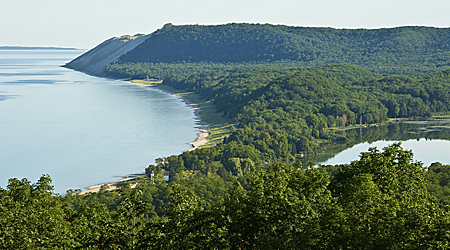
Continuing last Fridays’ musings on perception – wiring and plasticity of the visual system and moments of epiphany – I thought of my affinity (above) and my special moments prompted by coastlines.
Putting aside my book and looking down into the gleaming shoreline of a Great Lake, I exploded in ecstasy, immediately followed by fear that the intensity of my emotion meant that I was no longer a mortal human in a plane flying from Boston to Detroit.
My Jadebusen experience was also triggered by surprise when, again looking up from my book, I discovered that the plane from Amsterdam to Bremen took the unusual route of flying over my home bay. This time, I greeted the sunny coast line of my childhood feeling a warm glow of recognition.
Walking along dykes as child, I must have wired myself for the patterning of coastlines.
Continuing in this self-analysis, enjoying wildflowers on grassy dykes, I wired myself for loving meadows rather than the exuberance of flowering gardens. Looking at my grandfather’s apple tree, I wired myself for appreciating apple orchards.
I haven’ t figured out my affinity for mountains. A scientist might think that my genetic heritage was adapted to the mountaineous homelands of my ancestors. A yogi might think of past life experiences. Or perhaps, I simply experience mountains as painted coastlines in the sky?
Gross visual plasticity is terminated early through the maturation of inhibitory neurons. Yet, there appears to be later learning with regard to perception as D. found out when he focused on a full and compact right ear.
My two epiphanies were triggered by unexpected sights related to coastlines. It seems fitting that Augenblick is the German word for ‘moment’, literally translated as ‘look of eye’.
How does an artist reaches our spirit given our selective imprintings?

A very thought provoking post. Just some random thoughts of my own:
“The real voyage of discovery consists not in seeking new landscapes, But in seeing with new eyes. –Marcel Proust
Someone once told me, “We see what we know.” So maybe a form of enlightenment is a flash of seeing what we don’t know.
Maybe the key is understanding that we are dpendent upon and connected to everything. It’s all spirit, just stay open.
Birgit,
You imply that your love of coastlines is related to your past repeated perceptions of them, for example walking along the dikes. But I think you were closer to the mark with your last post, shades of grey, when you mentioned childhood influences. Though you’re certainly right that the raw subjects of perception affect brain “wiring,” I think that much more important are the emotional events or flavor associated with a place or other perception. A single occurrence can strongly influence our feelings about something forever.
Isn’t it precisely because of the selective imprints that the environment stamps on our neural systems that no single artist can manage to reach nor assuage the multitude?
Affinity to a particular style or pattern in art is again modulated and mediated by past experiences and all the hapless artist can hope to reach for would be selective subsets of the multitude (only those whose neural dispositional states appeal to similarly resonant neural patterning inherent in the artist who does it either by accident or by design).
A wolf child would have no art sense because of the absence of any specific conditional triggers from the environment.
Nice post – made me think and just keep writing…
Tree,
It is all spirit, just stay open. I love it.
A couple of days ago, I experienced landscapes and seascapes as dancing shapes (no mind altering substances). A few weeks ago, I snapped thousands of photos of Franny and Nino (3 and 5 yr) playing at a beach capturing their continuous motions. My newfound sensitivity to motion was contrasted by last night’s dream of a parade of people who, at moments, “turned into pillars of salt”, perhaps putting my old ways of being static into a garbage can, following Francis Crick’s thinking of dreams.
There is hope that even a grandmother can learn to flow.
Steve:
The wise one will advise you not to break up with somebody in your favorite restaurant.
Steve and Jay,
In term of emotional events triggering learning, my favorite example is Allen Gelperin’s classical finding that taking one bite out of a potato laced with quinine will forever make Limax selectively shun potatoes, one of its favorite foods.
Steve,
Walking my dog along the dike as a child (my assigned daily task), I only experienced sunshine during the short summer months. The long fall, winter and spring at the Northern latitude where I grew up were overcast. While having experienced mostly ‘shades of grey’, I remember the rarer sunny days (on which I prayed to the Egyptian sun gods) more vividly. Thus, both sunny and grey coast lines were the nature of my childhood.
Birgit:
Limax you say?
Just finished Google mapping the coast of Corsica. It was O.K., but not as exciting as the 30,000 island area of eastern Georgia Bay. That’s amazing.
Jay,
the Giant Garden Slug, Limax maximus.
Corsica’s shape makes me feel that wind and waves are blowing it westwards.
Birgit:
Are you sure that’s not slimax maximus?
In that case there could be a jurisdictional dispute between France and Spain should things blow too far. Now I’m off to Google the coast of Maine.
Jay,
finally it dawned on me what Corsica reminds me of.
Birgit,
I suddenly saw that your question has something to do with what I was saying to Sunil in his later post. Perhaps this is the key to his desire to evaluate art that will stand the test of time — whether the artist can reach us in spite of or within the context of our imprintings.